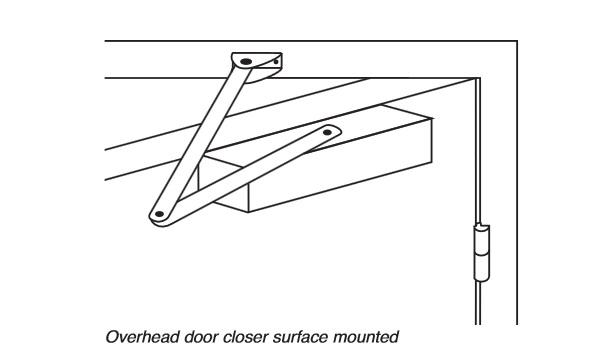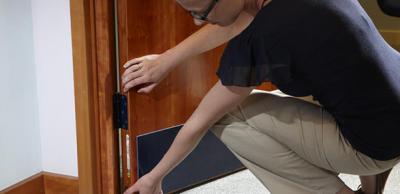New guide: Door closers on fire doors
Controlled door closing devices are commonly used in both domestic and commercial buildings. But did you know these devices have limitations when it comes to their effectiveness on fire doors? Installing the wrong device could prove costly or even fatal.
A new guide from the Door and Hardware Federation (DHF) offers useful information detailing key operating and performance statistics for fire door closers based on the requirements of BS EN 1154, which classifies door furniture using a six-digit coding system. The coding system covers type of use, mass of the door, fire behaviour, and resistance to corrosion.
There is a fire behaviour grade ranging from 1-4 that you must take note of when considering the mass of the door being used. Only those door closers achieving grade 3/4 are acceptable on a fire door. Lower-rated closers do not have sufficient closing power to ensure they will remain closed in fire situations.
Important considerations for door closers
- The door closer must be installed in accordance with the manufacturer’s installation instructions and should be capable of closing the door from any angle to which it may be opened
- The door closer should not include a hold open device unless it is an electrically powered device in accordance with EN 1155
- Control regulators should be either concealed or operable only by means of a tool
- The design of a door closer should be such that it is not possible to inhibit its closing action in any way without the use of a tool
- Any ‘delayed action’ function should be capable of adjustment to less than 25 seconds between the door closing angles of 120° and the end of the delay zone
- The door closer should have been incorporated in a door assembly that satisfied the appropriate criteria of a fire test. The test should have been on a full sized assembly in accordance with EN 1634-1.
- Where the door closer is intended for use with other, significantly different arm assemblies (for example slide tracks) which may be supplied separately, that combination should also be tested according to the requirements of EN 1154.
More details on the guide can be downloaded free of charge from the DHF website.
Sign up to the building bulletin newsletter
Over 48,000 construction professionals have already signed up for the LABC Building Bulletin.
Join them and receive useful tips, practical technical information and industry news by email once every 6 weeks.
Subscribe to the Building Bulletin




Comments
Locks and self closure dilemma
Submitted 6 years 6 months ago
I live be in a block of privately owned 14 flats. We are in the process of having new fire doors installed replacing the old store cupboards doors which belong to each flat. Each cupboard stores our gas meters and soil pipes plus electrics. We are having self closures as well as locks. The residents do not want this but this is the law isn’t it?
Reply to: Locks and self closure dilemma
Submitted 6 years 6 months ago
In general terms it will depend on whether the store is within the common parts or within the individual flat. If it is a store door in the common parts, it will not require a self-closing device but will need a disk on the door which notes 'Fire Door keep locked shut'.
The period of fire resistance will depend on the location. The replacement of fire doors will usually require a Building Regulation application to be submitted. For specific pre-application advice on your proposals and for advice on how to make a building regulation application, please contact your local building control team directly. You can find their contact details by entering the postcode of your project in the 'find your council' bar at the top of our website.
Kind regards,
LABC
Door closers
Submitted 6 years 3 months ago
Reply to: Door closers
Submitted 6 years 3 months ago
It's not clear from the question what building or situation this relates to but you can find guidance on fire doors within Appendix B in Approved Document B Volume 1 (for houses) and Volume 2 (for flats and other buildings). Within flats, the flat entrance doors of common areas need to have self-closing devices fitted.
Your local building control team would be pleased to provide free pre-application advice on this. You can find them by entering the postcode of your property in the 'find your council' bar at the top of our website.
Kind regards,
LABC
Fire door and self closer on a Server room?
Submitted 6 years 2 months ago
Just wondering if its a requirement to have a self closing door, and the door to be a fire rated door / and glass, For the office server room/ IT room in an office
We are moving office and I want to make sure our fit out company are complying
C02 extinguisher will be with 15m of server room and the room will be A/C cooled but would still pose a risk if electrical fault occurred.
Your thoughts appreciated.
Thanks
T
Reply to: Fire door and self closer on a Server room?
Submitted 6 years 2 months ago
The question doesn't contain sufficient information to determine whether the IT/server room is required to be a fire-rated enclosure. A building control body should be handling the fit-out of your new offices and would be able to determine the compliance of the work being carried out. You can find your local building control team by entering the postcode of the office in the 'find your council' bar at the top of our website.
Regards,
LABC
Fire door closer to strong for elderly residents.
Submitted 5 years 10 months ago
I have mobility scooter but unable to use it due to the fact that the outside door having a door closer. For me to get out of the building I would need to wedge open the door. I am unable to do this door due to my inability to physically wedge the door open long enough for me to exit. Are there door closers on the market that allow enough time to get through the door safely. The current closer is a danger not only to the elderly but anyone entering and exiting the building. The 10 year guarantee is with LABC
Reply to: Fire door closer to strong for elderly residents
Submitted 5 years 10 months ago
Sorry to hear that you and other residents are having issues with the main door fire door closer. You should get your local building control team to have a look - find their details by entering the postcode of your block of flats in the 'find your council' bar at the top of our website.
Regards,
LABC
new fire door closer
Submitted 5 years 7 months ago
Reply to new fire door closer
Submitted 5 years 7 months ago
Thanks very much for your query.
Door closing devices fitted to fire-resisting doors are required to perform one of two functions, dependent on whether or not a latch is fitted to the door. These functions are considered “essential”for the door to achieve its intended fire-resistance rating:
1) To close a latched door into a position where the latch engages. Once the latch is engaged, the closers have no further essential role to play.
2) To close an unlatched door into its frame and maintain this condition for a period during fire exposure, until the heat-activated sealing system takes over the role of keeping the door in the closed position.
Surface-mounted fire door closers can suffer damage and become inoperative during a fire if they are mounted on the exposed face of the door. However, this is likely to be after residents have left the flat. If their sole function is to close the door with a latch, when they have done this, any damage suffered will not affect the integrity of the door.
As such there is no ‘right side’ to locate the closer. This is usually done on the internal face of doors purely for cosmetic reasons of looks and minimises any potential damage to the closer if sited in the common area.
Kind regards
LABC
Add new comment